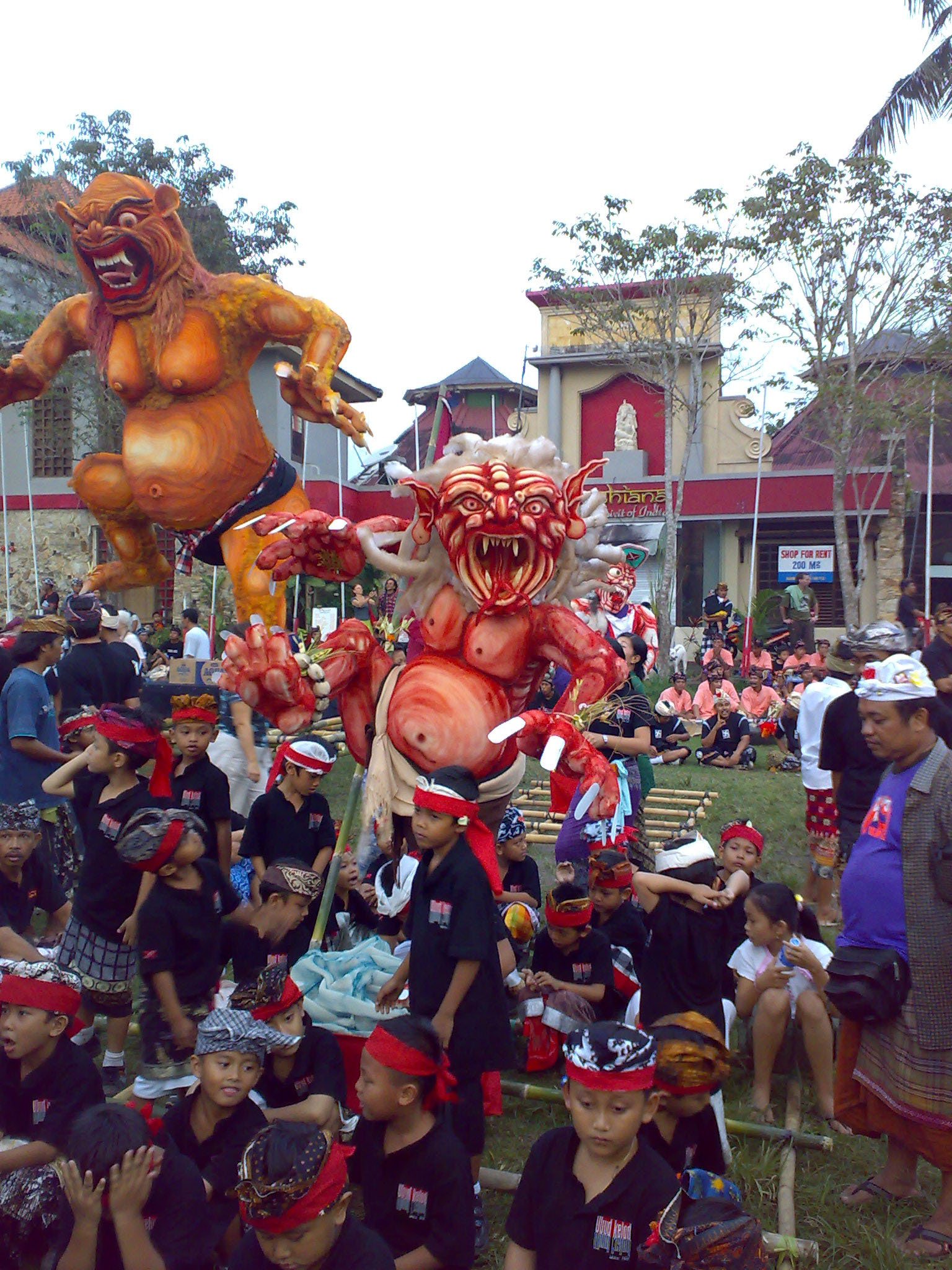Ogoh-Ogoh on:
[Wikipedia]
[Google]
[Amazon]


 Ogoh-ogoh are statues built for the Ngrupuk parade, which takes place on the eve of
Ogoh-ogoh are statues built for the Ngrupuk parade, which takes place on the eve of


 Ogoh-ogoh are statues built for the Ngrupuk parade, which takes place on the eve of
Ogoh-ogoh are statues built for the Ngrupuk parade, which takes place on the eve of Nyepi
Nyepi is a Balinese "Day of Silence" that is commemorated every ''Isakawarsa'' (Saka new year) according to the Balinese calendar (in 2023, it falls on March 22). It is a Balinese celebration mainly celebrated in Bali, Indonesia. Nyepi, a publi ...
day in Bali
Bali () is a province of Indonesia and the westernmost of the Lesser Sunda Islands. East of Java and west of Lombok, the province includes the island of Bali and a few smaller neighbouring islands, notably Nusa Penida, Nusa Lembongan, and Nu ...
, Indonesia
Indonesia, officially the Republic of Indonesia, is a country in Southeast Asia and Oceania between the Indian and Pacific oceans. It consists of over 17,000 islands, including Sumatra, Java, Sulawesi, and parts of Borneo and New Guine ...
. Ogoh-ogoh normally take the form of mythological beings, mostly demons. As with many creative endeavours based on Balinese Hinduism
Balinese Hinduism ( id, Agama Hindu Dharma; Agama Tirtha; Agama Air Suci; Agama Hindu Bali) is the form of Hinduism practised by the majority of the population of Bali.McDaniel, June (2013), A Modern Hindu Monotheism: Indonesian Hindus as ‘P ...
, the creation of Ogoh-ogoh represents spiritual aims inspired by Hindu philosophy
Hindu philosophy encompasses the philosophies, world views and teachings of Hinduism that emerged in Ancient India which include six systems ('' shad-darśana'') – Samkhya, Yoga, Nyaya, Vaisheshika, Mimamsa and Vedanta.Andrew Nicholson (20 ...
.
The main purpose of the making of Ogoh-ogoh is the purification of the natural environment of any spiritual pollutants emitted from the activities of living beings (especially humans). The forms of Ogoh-ogoh represent the Bhuta-Kala ( Bhuta: eternal energy, Kala
Kala or Kalah may refer to:
Religion Hinduism
*Kāla, a Sanskrit word meaning ''time''
*Kāla, a Hindu deity of time, destiny, death and destruction closely related to Yama and Shiva.
*Kalā, a Sanskrit word meaning ''performing arts''
* Kala Bo, ...
: eternal time), according to Hindu teachings. The imperceptible potentials of nature cannot be thoroughly explored by anyone. Philosophically, civilized men are required to manage the natural resources without damaging the environment itself.
Aside from being the symbol of Bhuta-Kala, Ogoh-ogoh is considered a symbol of modes of nature that form the malicious characters of living beings. Each village usually builds one Ogoh-ogoh mainly built by each village's Seka Truna Truni (Balinese village's youth organization), but often some smaller ogoh-ogoh also built by groups of children around the village. Some artists also usually build one. After being paraded on a convoy around the town, finally it is burnt to ashes in a cemetery as a symbol of self-purification.
An Ogoh-ogoh is normally standing on a pad built of timber planks and bamboos. The pad is designed to sustain the Ogoh-ogoh while it is being lifted and carried around the village or the town square. There are normally eight or more men carrying the Ogoh-ogoh on their shoulders. This procession is accompanied by orchestral music performed by the youth. The use of flares is also a main part of the parade.
During the procession, the Ogoh-ogoh is rotated counter-clockwise three times. This act is done at every T-junction and crossroad of the village. Rotating the effigies during the cremational parade and the eve of Nyepi represents the contact of the bodies with the spirits. It is intended to bewilder the evil spirits so that they go away and cease harming human beings.
The Ogoh-ogoh is a very recent addition to the Nyepi ceremonies, first appearing in Denpasar in the early 1980s. At that time, they were carefully monitored for any criticism of the Suharto
Suharto (; ; 8 June 1921 – 27 January 2008) was an Indonesian army officer and politician, who served as the second and the longest serving president of Indonesia. Widely regarded as a military dictator by international observers, Suharto ...
regime.
See also
*Namahage
The are demonlike beings portrayed by men wearing hefty ''oni'' (ogre) masks and traditional straw capes (''mino'') during a New Year's ritual, in local northern Japanese folklore of the Oga Peninsula area of Akita Prefecture.
General descripti ...
– demons in Japan celebrated on new year
References
{{reflist , refs = {{cite news , title = In Bali, a holiday for the ears , last = Hogue , first = Thomas , date = 2006-03-24 , work =The New York Times
''The New York Times'' (''the Times'', ''NYT'', or the Gray Lady) is a daily newspaper based in New York City with a worldwide readership reported in 2020 to comprise a declining 840,000 paid print subscribers, and a growing 6 million paid ...
, issn = 0362-4331
, url = https://www.nytimes.com/2006/03/24/opinion/24iht-edhogue.html
, accessdate = 2011-03-07
{{cite news
, last = Onishi
, first = Norimitsu
, authorlink = Norimitsu Onishi
, title = Silence Befalls Bali, but Only for a Day
, date = 2011-03-06
, work = The New York Times
''The New York Times'' (''the Times'', ''NYT'', or the Gray Lady) is a daily newspaper based in New York City with a worldwide readership reported in 2020 to comprise a declining 840,000 paid print subscribers, and a growing 6 million paid ...
, issn = 0362-4331
, url = https://www.nytimes.com/2011/03/07/world/asia/07indonesia.html
, accessdate = 2011-03-07
Balinese art
Balinese mythology